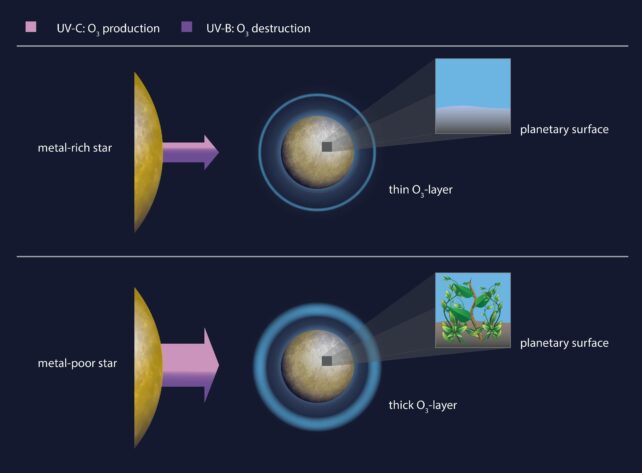A team of astronomers led by Anna Shapiro of the Max Planck Institute for Solar System Research in Germany has narrowed down the options.
According to a new analysis, Earth-like exoplanets orbiting Sun-like stars with a relatively low metal content are more likely to be protected from harmful UV radiation that could hinder life by exposing it to the threat of genomic damage.
This may seem counter-intuitive since stars with a lower metal content emit more ultraviolet light. But the team's work shows that a planet with an oxygen-rich atmosphere has a thicker ozone layer, giving a world orbiting a metal-poor star more protection than one with a metal-rich host.
"Our findings," they write in their paper, "imply that planets hosted by stars with low metallicity are the best targets to search for complex life on land."
Not all stars are created equal. They can be small, cool, and dim, or large, hot, and blazing. And although they have some basic elements in common, their chemical composition can vary widely.That's because, very early on in the history of the Universe, there were no heavy elements. Hydrogen and helium were pretty much all there was; from these elements, the first stars were born, their hearts giant engines that smashed atoms together to create bigger, heavier atoms.
When these stars died, the violent process created even heavier elements and spewed and seeded those elements out into space to be taken up in new stars born from clouds of interstellar dust and gas.
These elements change the star's radiation output. Stars with a greater proportion of elements heavier than hydrogen and helium, or higher metallicity, emit less ultraviolet radiation than stars made of lighter stuff. And we know, from living our lives here on Earth, that UV radiation can harm delicate land-dwelling organisms, causing various types of damage to DNA.
The role of UV irradiation on the potential habitability of alien worlds had not been explored, so Shapiro and her colleagues investigated using Earth as the model.

An alien civilization looking at the Solar System from a great distance might consider Earth inhospitable to life. At our current distance from the Sun, irradiation levels from the wavelength bands UV-C and UV-B are, the researchers say, "well above the maximum tolerable level for terrestrial life."
But our atmosphere blocks most of it: Oxygen, or O2, in the upper atmosphere absorbs most of the UV-C, and the layer of ozone, or O3, in the middle atmosphere absorbs the UV-B.
UV radiation is involved in the creation and destruction of ozone. Wavelengths below 240 nanometers break apart O2 molecules; free-floating O atoms can then collide with and bind to O2 molecules to form O3. Longer wavelengths, however, break up the O3 through photodissociation. The resulting O atoms can then recombine into O2.
Several factors influence a star's UV output, including its metallicity and temperature. Shapiro and her team modeled Earth-like worlds orbiting Sun-like stars, tweaking the parameters that would influence UV radiation to see what effect that would have on the orbiting exoplanet.
They found that metallicity was more important than temperature in influencing the habitability of the exoplanet, but in a way that was totally opposite to what might be assumed. The lower metallicity stars, with more UV radiation, were likelier to have habitable worlds.
That's because the way the UV radiation interacted with the oxygen in the atmosphere created a better shield, resulting in less of that radiation reaching the surface of the exoplanet.
"Paradoxically, whereas stars with higher metallicity, which have appeared later in the history of the Universe, emit less UV radiation, in oxygenated planetary atmospheres the associated stellar radiative spectrum allows less O3 formation, which enhances UV penetration, making the conditions on planets orbiting these stars less friendly for the biosphere on land," the researchers write.
"We thus find that the surface of planets orbiting metal-rich stars is exposed to more intense UV radiation than the surface of planets orbiting metal-poor stars. Therefore planets in the habitable zones of stars with low metallicity are the best targets to search for complex life on land."
It's not enough to be able to rule out higher metallicity stars just yet. But the analysis and characterization of exoplanet atmospheres with instruments such as the James Webb Space Telescope will help scientists figure out if their findings are along the right path, bringing us one tiny step closer to finding signs of life on an alien world.
The research has been published in Nature Communications







No comments